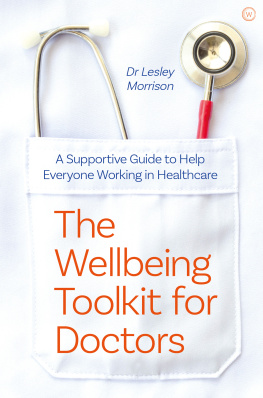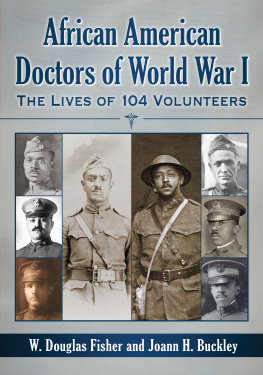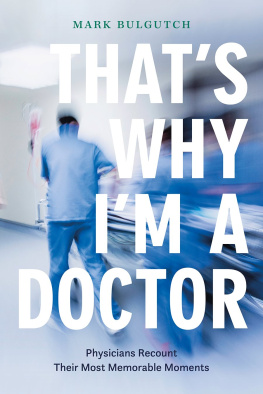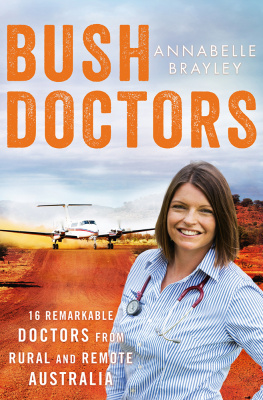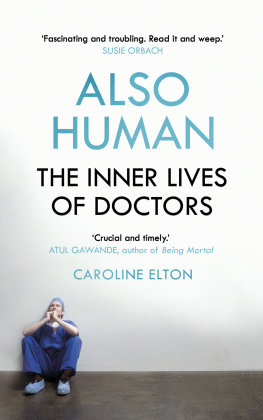The
Surprising
Lives of
Small-Town
Doctors
Edited by
Dr. Paul Dhillon

2016 Paul Dhillon
All rights reserved. No part of this work covered by the copyrights hereon may be reproduced or used in any form or by any means graphic, electronic, or mechanical without the prior written permission of the publisher. Any request for photocopying, recording, taping, or placement in information storage and retrieval systems of any sort shall be directed in writing to Access Copyright.
Printed and bound in Canada at Friesens.
Cover design: Duncan Campbell, University of Regina Press
Text design: John van der Woude Designs
Copy editor: Kirsten Craven
Proofreader: Katie Doke Sawatzky
Cover art: cover illustrations from the Noun Project: Bear by Loren Klein; Stethoscope by Andr Luis Gollo; Sea Plane, public domain.
Library and Archives Canada Cataloguing in Publication
The surprising lives of small-town doctors / edited by Paul Dhillon.
Issued in print and electronic formats. isbn 978-0-88977-431-5 (paperback). isbn - - 88977 - - (html). isbn - - 88977 - - (pdf)
. Physicians Canada Biography.. Physicians Canada Anecdotes.. Medicine, Rural Canada Anecdotes.. Rural health services Canada Anecdotes.. Canada Rural conditions Anecdotes. I. Dhillon, Paul 1981 -, editor
r464.a1s 2016 . ' c2 016-900160-1 c2016-900161-x
We acknowledge the support of the Canada Council for the Arts for our publishing program. We acknowledge the financial support of the Government of Canada. / Nous reconnaissons lappui financier du gouvernement du Canada. This publication was made possible through Creative Saskatchewans Creative Industries Production Grant Program.

To my Sarah
Contents
by Dr. Lawrence Loh
by Dr. Braam de Klerk
by Dr. Paul Dhillon
Yukon
Northwest Territories
Nunavut
Newfoundland and Labrador
Prince Edward Island
Nova Scotia
New Brunswick
Quebec
by Dr. Baijayanta Mukhopadhyay
Ontario
Manitoba
Saskatchewan
Alberta
by Dr. Anna-Kristen Siy
British Columbia
Foreword
It is estimated that nearly per cent of humankind will live in an area defined as urban by the year 2030 . Not unsurprisingly, there has been a growing focus on the relationship between urbanization and health; our cities are busier, more auto-dependent, and more isolating than ever, which has driven up rates of chronic disease, mental health concerns, and societal upheaval. As economic and cultural drivers, cities attract enormous amounts of attention from governments to ensure that their contribution to nation-states continues uninterrupted.
Yet for countries like Canada, it is impossible for us to forget the swathes of population that live in remote and rural areas. From the vast frontiers of the Arctic and the North to the lush farmland of southern Ontario and the Prairies, Canadians by and large are defined as much by the hardy men and women in Prince Rupert and Cape Breton as they are by the frenetic pace of Toronto and Calgary. History, economics, and policy continue to sculpt the flows by which Canadians migrate, work, live, and play in our vast and diverse country, and these factors in turn influence their health and the nature of the health care they receive.
As a third-year medical student, I drove through northern Ontario to a rural rotation in family medicine and public health in Kenora, Ontario a beautiful town where Winnipeg was the city, and where you could follow up your suspect flu cases just by shopping in the local Safeway. Rural living provided me with a different perspective on Canadian culture, history, and potential, and also on the essence of human nature. I imagine the stories in this book will do the same for you.
We are fortunate to live in a nation that, for those of us who call it home, affords us the freedom to choose from any number of tapestries on which our lives can unfold from Arctic tundra to untouched coastlines, from boundless prairies to concrete jungles. The stories in this book celebrate not only our national identity but the national spirit that drives us ever forward, believing that in diversity lies our strength.
Dr. Lawrence Loh
Associate Medical Officer of Health, Peel Public Health
Adjunct Professor, Clinical Public Health, University of Toronto Director of Programs, The 53rd Week Ltd.
Message from the Society of Rural Physicians of Canada
A need to tell and hear stories is essential to the species Homo sapiens second in necessity apparently after nourishment and before love and shelter. Millions survive without love or home, almost none in silence; the opposite of silence leads quickly to narrative, and the sound of story is the dominant sound of our lives.
Reynolds Price , A Palpable God
Rural Canada is a breeding ground for stories. Rural medicine is a fertile breeding ground for stories. When rural doctors and patients get together, stories abound. When rural doctors get together, the telling of stories becomes epidemic.
Patients use stories to illustrate their problems. An old trapper once told me, I can still write my name in the snow when I pee, but its awfully close to my toes!
Doctors use stories to help patients understand their diagnosis, treatment, and recovery. Inuit relate easily when told, If your son stops barking like a seal, his croup is getting better.
Doctors tell stories to other doctors to share adventures and experiences. The Society of Rural Physicians of Canada (SRPC) is the national voice of Canadian rural physicians. Founded in 1992 , the SRPCs mission is to provide leadership for rural physicians and to promote sustainable conditions and equitable health care for rural communities.
On behalf of its members and the Canadian public, the SRPC performs a wide variety of functions, one of which is fostering communication among rural physicians and other groups with an interest in rural health care.
Stories are the best way that I know of to communicate, and the hallways and lecture halls at rural conferences are alive with the sound of stories. We are always amazed at how well we can relate to other rural docs, whether Australian, South African, Kiwi, Pacific Islander, or many others. It is shared experiences and shared stories that make this happen.
I trust the stories in this book will contribute to the great practice of rural medicine and the even greater practice of storytelling.
Dr. Braam de Klerk, CM, MB, ChB
Past President, Society of Rural Physicians of Canada
Preface
For a writer, where does the physical book emotionally begin? In the case of this book, I remember the moment exactly.
It was a chilly but clear-blue-sky day in rural Saskatchewan. A phone call from the nurse had awoken me from my Saturday morning slumber and I trundled over the short drive to the hospital to see the patient who needed some care.
Its really nothing, I overheard the sprightly ninety-two-year-old state emphatically as I was ushered into the examination room. I dont see why you had to call back the doctor.


